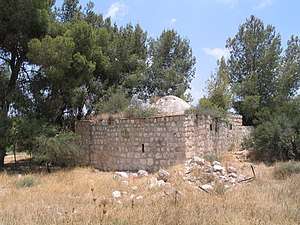Tamim al-Dari
Tamim bin Aws ad-Dari (Arabic: تميم بن أوس الداري) (died 661) was a companion of the Islamic prophet Muhammad.
| Part of a series on |
| Islam |
|---|
 |
|
Biography
Originally a Christian priest, al-Dari lived in Palestine and belonged to the Banu al-Dar—a clan of the Lakhm tribe. His first contact with Muhammad was in 628 CE when he led a delegation of ten other Banu al-Dar members. Previously Muhammad granted Banu al-Dar a part of the revenues of conquered land after the Muslim victory at the Battle of Khaybar. Al-Dari confronted Muhammad to receive the revenues and after meeting him, al-Dari embraced Islam and settled in Medina.[1]

After his conversion, al-Dari became an adviser to Muhammad, particularly on public worship. His advice included the introduction of oil lamps in mosques. He is traditionally considered to be the first narrator of Islamic religious stories. Many of his stories included ones on the end of the world, Dajjal beasts and the coming of the Antichrist.[1] His wife thought he was dead and married to another man. The matter was communicated to Caliph Umar (r. 634–644), and he referred it to Ali who said that Muhammad had foreseen all that would happen to Tamim and left the wife to have her own choice between the two husbands. The wife ultimately decided to go back to al-Dari.[1]
Prior to Muhammad's death, al-Dari was granted a large qita'a (akin to a fief) for control of Hebron, Beit Einun and the surrounding area, although at that time Palestine was still under Byzantine control.[1] The deed was written up by Ali and when the Muslims conquered Palestine in 634, al-Dari acquired the territory. Originally, al-Dari's role as the owner of the qita'a was to collect the kharaj (land taxes). He was forbidden to enslave any of the locals or sell their property.[3]
In 655, al-Dari left Medina to reside in his native Palestine where he died in 661.[1] According to tradition, he is buried in the town of Bayt Jibrin (in the vicinity of Hebron), destroyed by Israel in 1948.[4] Today his maqam (shrine) is abandoned and located just north to Kibbutz Beit Guvrin. According to the Egyptian historian Ibn Lahi'a (714–790), members of al-Dari's family were still the owners of his estates in Hebron and Beit Einun during the historian's lifetime.[5]
See also
- List of Sahaba
- Sunni view of the Sahaba
References
- Houtsma, M., Arnold, T.W. (1993).E.J. Brill's First Encyclopaedia of Islam, 1913-1936 BRILL, pp.646-648. ISBN 90-04-09796-1.
- Petersen, 2001, p. 122
- Gil, 1997, pp. 129-130
- Sharon, 1999, pp 140-141
- Elad 1996, pp. 26–27.
Bibliography
- E.J. Brill's First Encyclopaedia of Islam, 1913-1936 By M. Th Houtsma E.J. Brill's First Encyclopaedia of Islam, 1913-1936 By M. Th Houtsma p647
- Clermont-Ganneau, C. S. (1896). [ARP] Archaeological Researches in Palestine 1873-1874, translated from the French by J. McFarlane. 2. London: Palestine Exploration Fund. p. 463.
- Gil, Moshe (1997) [1983]. A History of Palestine, 634–1099. Translated by Ethel Broido. Cambridge: Cambridge University Press. ISBN 0-521-59984-9.
- Elad, Amikam (1996). "Pilgrims and Pilgrimage to Hebron (al-Khalil) during the Early Muslim Period (638–1099)". In LeBeau, Bryan F.; Mor, Menahem (eds.). Pilgrims & Travelers to the Holy Land. Omaha: Creighton University Press. pp. 21–62. ISBN 1-881871-15-0.
- Moudjir ed-dyn (1876). Sauvaire (ed.). Histoire de Jérusalem et d'Hébron depuis Abraham jusqu'à la fin du XVe siècle de J.-C. : fragments de la Chronique de Moudjir-ed-dyn. p. 227 ff.
- Petersen, Andrew (2001). A Gazetteer of Buildings in Muslim Palestine (British Academy Monographs in Archaeology). 1. Oxford University Press. ISBN 978-0-19-727011-0.
- Sharon, M. (1999). Corpus Inscriptionum Arabicarum Palaestinae, B-C. 2. Brill. ISBN 90-04-11083-6.
Further reading
- Cook, David (1998). "Tamīm al-Dārī". Bulletin of the School of Oriental and African Studies. 61 (1): 20–28.
- Scheiner, Jens (2016). "Single Isnāds or Riwāyas? Quoted Books in Ibn ʿAsākir's Tarjama of Tamīm al-Dārī". In Pomerantz, Maurice A.; Shahin, Aram A. (eds.). The Heritage of Arabo-Islamic Learning: Studies Presented to Wadad Kadi. Leiden and Boston: Brill. pp. 42–72. ISBN 978-90-04-30590-8.